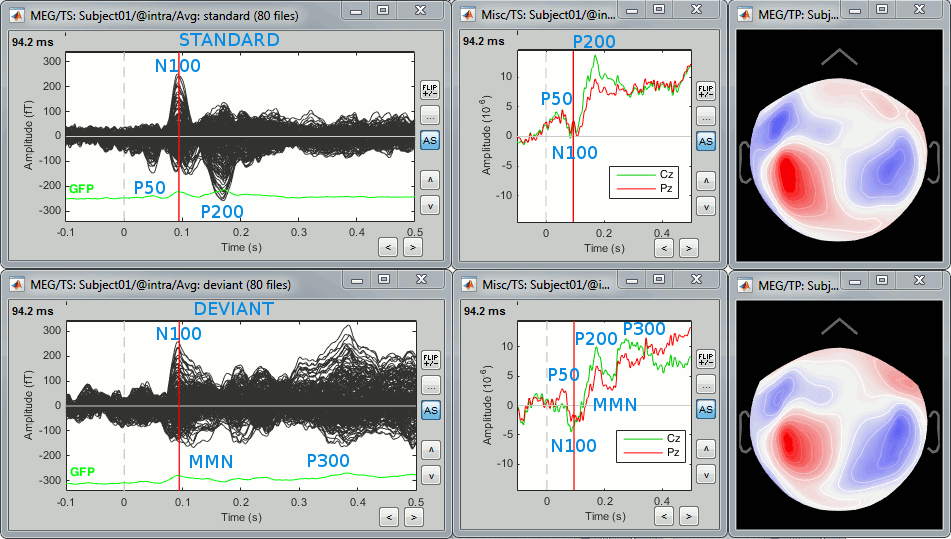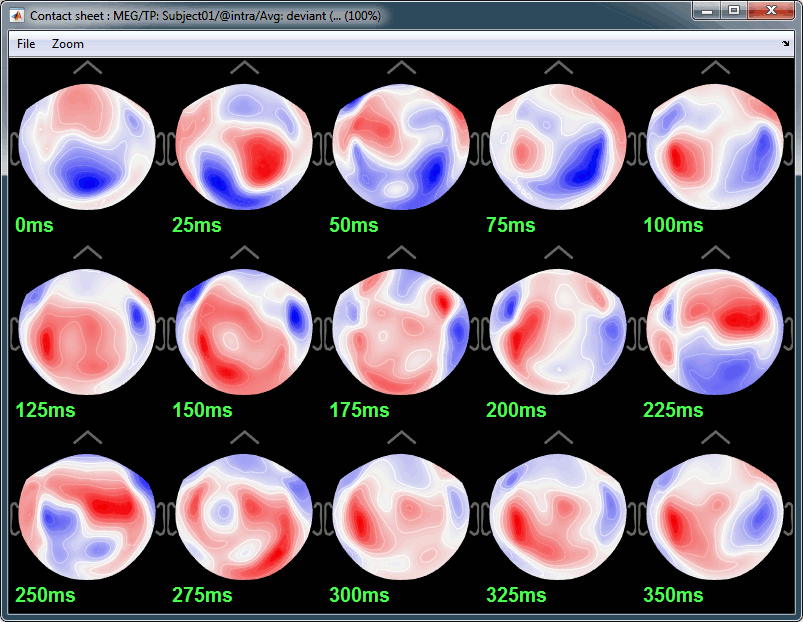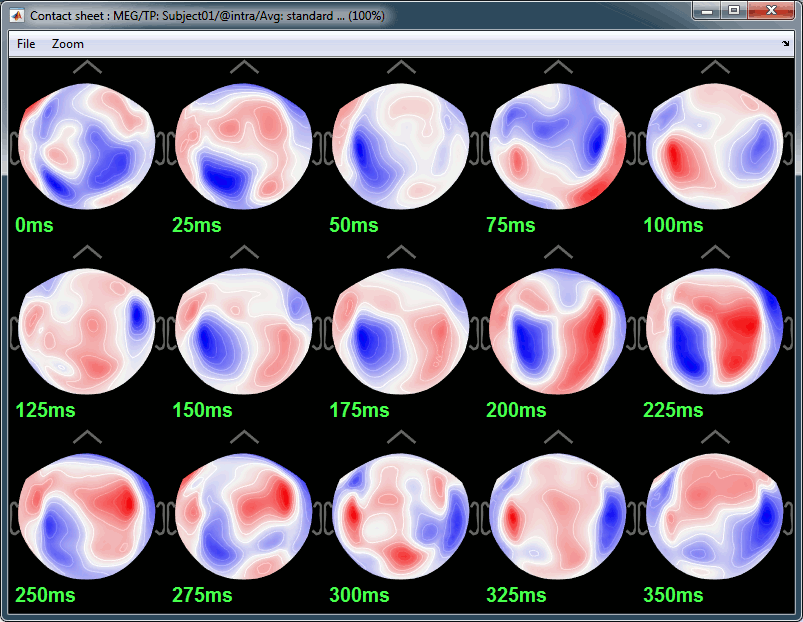Tutorial 16: Average response
Authors: Francois Tadel, Elizabeth Bock, Sylvain Baillet
All the epochs we have imported in the previous tutorial are represented by matrices that have the same size (same number of channels, same number of time points), therefore they can be averaged together by experimental condition. The result is called indifferently "evoked response", "average response", "event-related field" in MEG (ERF) or "event-related potential" in EEG (ERP). It shows the components of the brain signals that are strictly time-locked to the presentation of a stimulus.
Contents
Average trials separately
We will now compute the average responses for both the "standard" and "deviant" conditions, for each acquisition run separately. Note that in MEG, it is not recommended to average across acquisition runs which correspond to different head positions (ie. different "channel files"). If the head of the subject moved between two blocks of recordings, one sensor does not record the same part of the brain before and after, therefore the runs cannot be compared directly.
Drag and drop all the "standard" and "deviant" trials for both runs in Process1.
In the Process1 list, you can notice that the number of imported trials, for instance "(40 files)" does not match the number of files selected for processing (between brackets, eg. "[39]"). This difference is due to the bad trials that we have in those folders. The trials tagged with a red dot in the database explorer are ignored by all the processes. The total number of selected files is 458 instead of 280, it means that we have a total of 22 bad trials.
Select the process "Average > Average files".
Select: By trial group (folder average), Arithmetic average, Keep all the event markers.

You get two new files for each average:

Process options
Description of all the options of the process:
Everything: Averages all the files selected in Process1 together, creates only one file in output.
By subject: Groups the files by subject (ignoring the folders), creates one file per subject.
By folder (subject average): Groups by subject and by folder, ignoring the trial groups.
In the current configuration, it would produce two files, one for each acquisition run.By folder (grand average): Groups by folder, across the subjects. All the files located in folders with the same name would be averaged together, no matter in what subject they are.
By trial group (folder average): Groups by set of trials with the same name, separately for each folder and each subject.
By trial group (subject average): Groups by set of trials with the same name, for each subject. The separation in folders is ignored. In the current configuration, it would produce two files, one for "deviant" and one for "standard".
By trial group (grand average): Groups by set of trials with the same name, ignoring the classification by folder or subject.
Function: Documented directly in the option panel.
Keep all the event markers: If this option is selected, all the event markers that were available in all the individual trials are reported to the average file. It can be useful to check the relative position of the artifacts or the subject responses, or quickly detect some unwanted configuration such as a subject who would constantly blink immediately after a visual stimulus.
Visual exploration
The average response contains interesting information about the early brain operations that occur shortly after the presentation of the stimulus. We can explore two dimensions: the location of the various brain regions involved in the sensory processing and the precise timing of their activation. Because those two types of information are of equal interest, we are typically explore the recordings with two figures at the same time, one that shows all the signals in time, one that shows that spatial distribution at one time.
Open the MEG recordings for the deviant average in Run#01: double-click on the file.
- In the Record tab: Select the "butterfly" view more (first button in the toolbar).
In the Filter tab: Add a low-pass filter at 100Hz.
- In the Record tab: Delete the "cardiac" event type, we are not interested by their distribution.
- This figure shows a typical an clean evoked response, with a very high signal-to-noise ratio. This represents the brain response to a simple auditory stimulation, the large peak around 90ms probably corresponds to the main response in the primary auditory cortex.
This is the response to the deviant beeps (clearly higher in pitch), for which the subject is supposed to press a button to indicate that he/she detected the target. These responses are represented with the "button" events, distributed between 350ms and the end of the average (many responses happened after 500ms). Because of the variabiliy in the response times, we can already anticipate that we won't be able to study correctly the motor response from this average. For studying the activity in the motor area, we need to epoch again the recordings around the "button" events.

Interpretation
Display the two averages, "standard" and "deviant":
Right-click on average > MEG > Display time series.
Right-click on average > MISC > Display time series (EEG electrodes Cz and Pz)
Right-click on average > MEG > 2D Sensor cap
In the Filter tab, add a low-pass filter at 100Hz.
Right-click on the 2D topography figures > Snapshot > Time contact sheet.
- Here are results for the standard (top) and deviant (bottom) beeps:

P50: 50ms, bilateral auditory response in both conditions.
N100: 95ms, bilateral auditory response in both conditions.
MMN: 100-200ms, mismatch negativity in the deviant condition only (detection of deviant).
P200: 170ms, in both conditions but much stronger in the standard condition.
P300: 300-400ms, deviant condition only (decision making in preparation of the button press).
Standard (right-click on the topography figure > Snapshot > Time contact sheet) :
Deviant:
Averaging across runs
Doing it for illustration purposes.
- As said previously, it is usually not recommended to average recordings in sensor space across multiple acquisition runs because the subject might have moved between the sessions. Different head positions were recorded for each run, we will reconstruct the sources separately for each each run to take into account those movements.
- However, in the case of event-related studies it makes sense to start our data exploration with an average across runs, just to evaluate the quality of the evoked responses. We have seen that the subject almost didn't move between the two runs, so the error would be minimal. We will compute now an approximate sensor average between runs, and we will run a more formal average in source space later.
- We have 80 good "deviant" trials that we want to average together.
Select the trial groups "deviant" from both runs in Process1, run process "Average > Average files" Select the option "By trial group (subject average)"
Standard error

